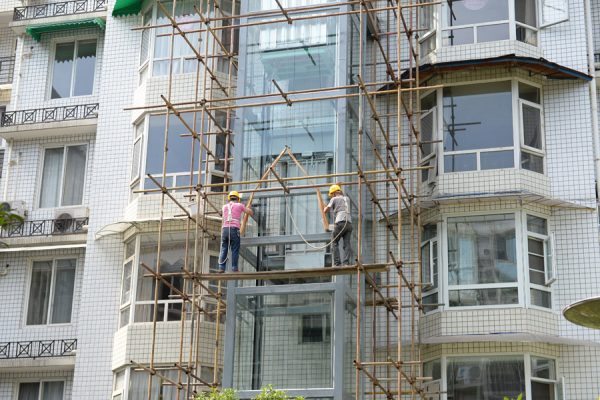
Elevators installed in old residential buildings make life easier for elderly. He Qi and Cao Chen report from Shanghai.
Li Baozhen lives in downtown Shanghai’s Hongkou district. For decades the 93-year-old had felt trapped and isolated from the rest of the world due to there being no elevator in the building to service her sixth-floor apartment.
That all changed in February this year when an elevator was installed in the residential building, built nearly half a century ago, allowing Li to avoid the slew of stairs that were previously the only means of access.
Climbing up and down the stairs had become an arduous task for Li in the past decade, only managing one trip downstairs a day with the use of a cane for support.
“I feel free now as I can go outside as long as I want,” Li said.
Li is not alone. Statistics shows that in Shanghai, there are more than 220,000 multistory residential buildings without elevators.
“About 70 percent of residents in those buildings are middle-aged or elderly people, for whom climbing up and down a flight of stairs is a physical torture,” said Zhang Jianxin from Jia Jia Le – the first social service agency in Shanghai to provide professional help for people who need elevators in their buildings
To free those residents – especially the elderly – from taking the stairs by installing elevators to old multistory residences has become a prominent task in Shanghai and many other cities – all with increasingly aging populations.
Due to the underdeveloped economic environment at the time, these six-or-seven-story buildings are not equipped with elevators and instead only have stairs, with two or three small apartments ranging from 25 to 60 square meters on each floor.
“Although they are not as decorative as high-rise commercial residential buildings built during the 21 century, old buildings are still the best choice for the elderly for their low property management fee – less than 10 yuan per month, and convenient locations – usually surrounded by markets, shops and public transportation,” Zhang said.
Additionally, due to the rapid economic development of today, soaring housing prices have deterred many of them from swapping or renting a relatively new apartment.
This has led to 70 percent of the residents’ in Shanghai’s 220,000 multistory residential buildings without elevators, being elderly, according to Zhang.
A 70-year-old woman surnamed Wang, said her physical condition is “too weak to climb up to her home on the sixth floor.”
For those who can’t afford moving to buildings with elevators, some have to be carried on the backs of others to go downstairs.
“We are eager to use a newly-built elevator,” Wang said.
Noticing the difficulties faced by this group of people, in 2009 Beijing became the first city in the country to deal with the problem. According to statistics from the Bureau of Quality Supervision in Beijing, a total of 150,000 old six-story buildings currently require elevators and match the conditions needed for installation.
The capital city plans to launch more than 400 elevator installation projects and to finish no less than 200 this year. The city has also set the goal of adding more than 1,000 elevators in multistory buildings by 2020.
Many cities such as Tianjin, Chongqing and Wuhan have also devised related policies and guidelines to support elevator installation projects for old buildings in recent years.
Shanghai first issued guidelines for installing elevators in old multistory residential buildings in 2011. The guidelines outline items such as the conditions for installation, distribution of costs and fire safety.
However, despite the governmental support, these actions have not gone as smoothly as expected.
For example, it took nearly four years for Shanghai to install its first elevator in an old residential building.
The seven-story No 7 building of Nujiang Yuan, in the city’s Putuo district, became the first of its kind to have an elevator installed in 2015.
Obstacles have proved real and hard to remove.
For example, according to the policy, a proposal for installing an elevator needs to be agreed on by 90 percent of the residents who live in the building and two-thirds of the residents in the same neighborhood. If the other 10 percent of residents are against the proposal, it will be vetoed.
Such a consensus can be hard to get.
Many ground floor residents do not agree with adding an elevator as it might block sunlight and ventilation, and create noise.
Some are also concerned about their housing prices, said Shi Jiankang, deputy president of the Kunming Elevator Association.
“Before adding elevators, the first- and second-floor apartments are more expensive than the fifth and sixth floor, as residents do not need to climb up stairs. But after the construction, the housing price situation will be reversed,” said Shi.
Cost sharing is another major issue open to disputes, Shi added.
According to the current policy, the government provides no more than 240,000 yuan for installing each elevator, which means the rest of the cost – around 260,000 to 460,000 yuan – should be covered by residents themselves.
It took the Nujiang Yuan building a year and almost 30 meetings attended by officials in the city and representative residents in the neighborhood to strike a consensus among all the 12 households living in the building.
They agreed that residents living on the higher floors paid more than those living on the lower ones and residents on the first floor needn’t pay at all.
Such an agreement, however, has become a reference for future projects to follow.
Apart from interpersonal and economic obstacles, low government efficiency has also caused trouble.
According to Gong Jianhao, who proposed an elevator project in a building on Wenshui East road in Hongkou district, from putting it forward in 2013, he spent three years communicating with different government bureaus and departments.
“We only spent a few months on solving the problems with residents, but it took years negotiating with the government,” said Gong. “I even went to the meteorological administration and the geology bureau to get permission.”
The elevator was finally installed in February.
Recognizing the administrative barriers, the government, wanting to build a convenient city for the elderly, simplified the 46 official stamps needed for approval to 15 in 2016, and then set up the Jia Jia Le office to help residents.
“We are dedicated to providing guidelines and instructions, and to helping residents in need on related issues, such as introducing the elevator companies, or communicating with related bureaus, contractors, neighborhood committees and neighbors,” Zhang said.
With the help of the agency, since its opening in Hongkou in March, five buildings in the district have had new elevators installed, three more are under construction and 19 are in preparation stages.
Like Hongkou, other districts across Shanghai have launched pilot projects in the past two years. Official data has shown that 12 elevators have been installed in multistory residential buildings, along with a total of 43 planned, as of last May.
For Zhang, the job of being a liaison for such projects has been fulfilling and rewarding.
There are not always headaches, but also heartwarming moments, she said.
“Most residents are really understanding and supportive, even those who live on the first floor,” Zhang said.
She recalled Ye Niangen, a 60-year-old resident, from a recent project. Despite living on the first floor, Ye agreed to the project immediately because she used to be the daughter of an aged mother living in a building without elevators.
“I know the pain,” Ye said.


